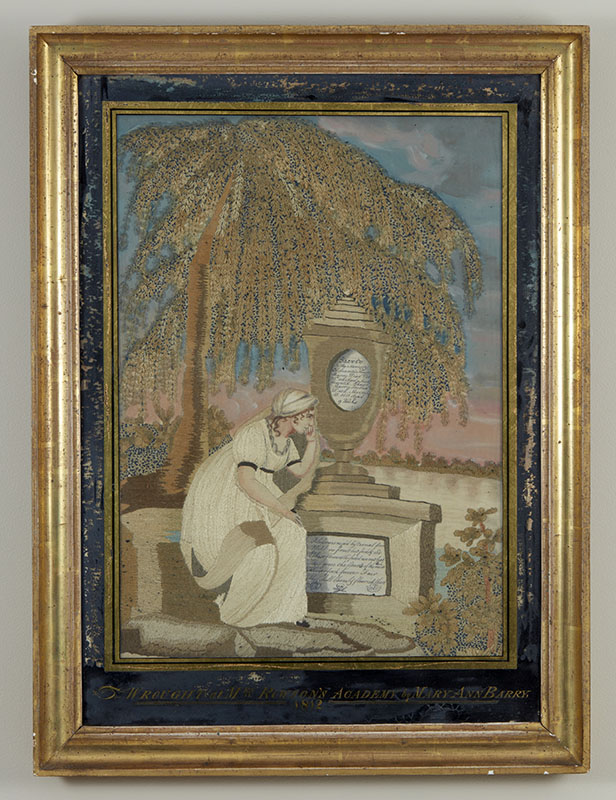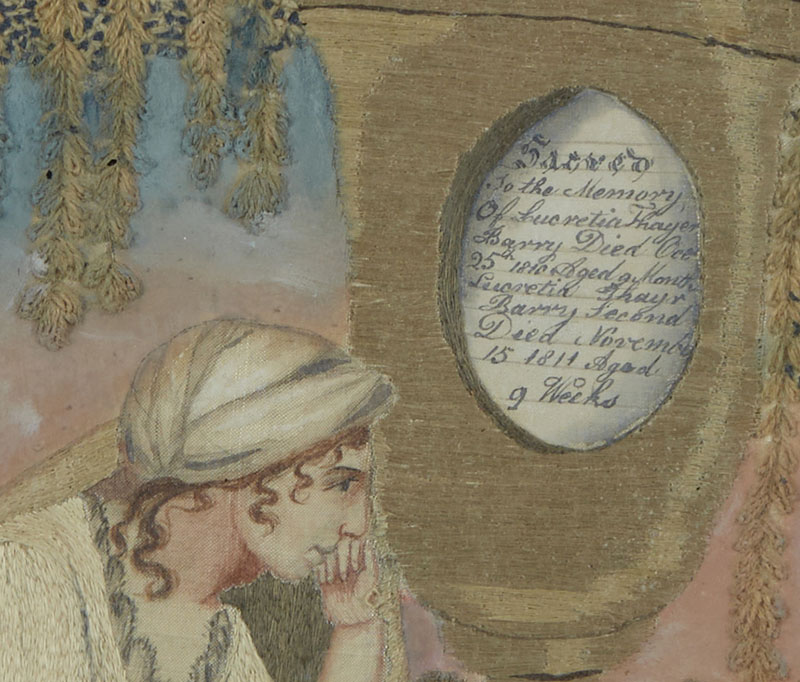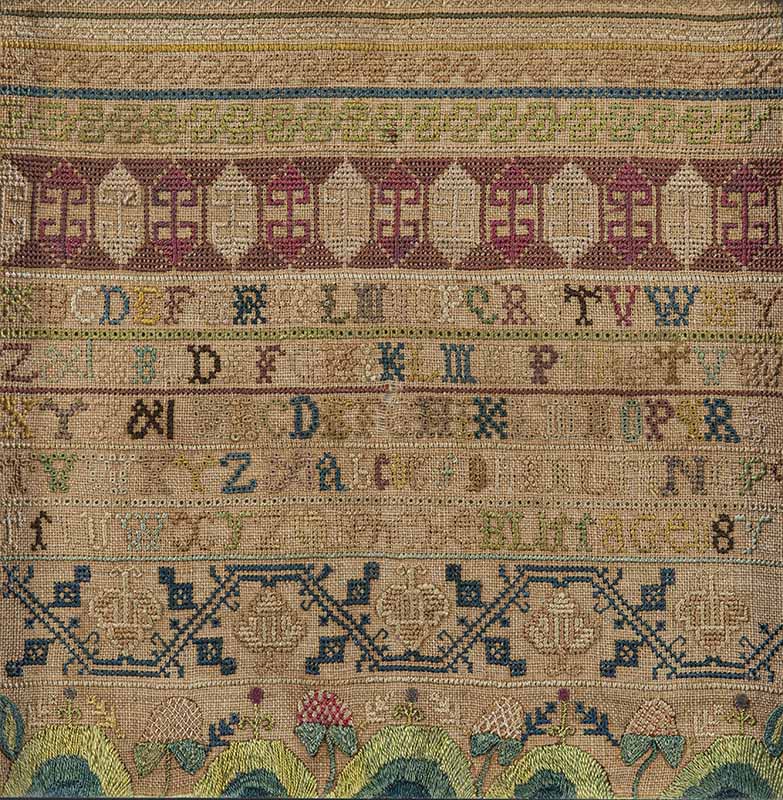Interwoven: Women’s Lives Written in Thread
by Reed Gochberg
The Concord Museum’s special exhibition Interwoven: Women’s Lives Written in Thread features samplers made by young women during the 18th and 19th centuries in Middlesex County, MA. From marking samplers to mourning pictures, this exhibition explores how samplers offer distinctive records of women’s lives, including practices of reading, genealogy, and mourning. Interwoven is on view at the Concord Museum through February 25, 2024.
The samplers in the Concord Museum’s collection open up a variety of stories about women’s lives and experiences. Created by young women attending schools and academies, they combine needlework, text, and visual art. Their colorful designs and intricate patterns demonstrate the importance of sewing as both an art form and a practical skill. Intended to showcase the students’ accomplishments, they capture emerging ideas about education in the newly formed United States and offer glimpses of the kinds of texts and ideas they may have discussed at schools and academies. Interwoven features a variety of samplers and needlework pictures, showing the numerous ways that the creators practiced their sewing skills and made these objects their own.
Interwoven begins by examining the role of needlework in women’s education in the early republic. Several of the samplers featured in Interwoven were made at Susanna Rowson’s Academy in Boston and Medford. At Rowson’s Academy, young women studied a wide range of subjects, including literature, geography, and history, reflecting new ideas about the importance of women’s education. Rowson herself was a writer and playwright, known for the novel Charlotte Temple (1791), the play Slaves in Algiers (1794), and other published works. She left a remarkable record of her school’s curriculum, including published accounts of student recitations and public events. The samplers produced at her Academy follow conventional patterns while also revealing clear mastery of needlework and exploring common topics relating to virtue, family, and mourning.
The texts selected for needlework offer a glimpse of the range of literature the makers might have been reading at school or at home. Samplers often featured quotations from poems, hymns, and other literary sources. A needlework by Lydia Hosmer (figure 1), for example, depicts Maria, a character from Laurence Sterne’s novel A Sentimental Journey (1777). Although young women were often discouraged from reading novels, Rowson—a novelist herself—likely encouraged her students to explore this medium. The budding seamstresses typically selected verses related to themes of youth, virtue, or mortality, following clear expectations about appropriate topics and behaviors.
Makers also seem to have drawn on a variety of sources and inspirations in identifying texts. Some samplers feature quotations taken from the Bible, hymnbooks, and other religious texts, but others were featured in popular periodicals or anthologies, connecting these projects with the circulation of printed texts. During this period, it was common for periodicals to feature excerpts from longer works and to reprint poems, anecdotes, and other short works that were published elsewhere.
Other samplers allow us to imagine students in conversation, whether at Rowson’s Academy or at other schools. An especially poignant work by Mary Ann Barry (figures 2, 3, and 4) is a mourning picture for her two younger sisters, both named Lucretia, who had died in the previous two years at the ages of nine months and nine weeks. In addition to their names and ages, Barry included an elegiac text, which she wrote in pen and ink on the silk ground:
Blossoms nip’t by Vernal frost
Yield no fruit but fade and die
Those flowers tho’ faded are not lost;
They grace the courts of the most High;
Forever fresh forever fair
They shall bloom and flourish there.
Barry’s work follows many of the conventions of mourning pictures from this period, including imagery of weeping willows, tombs, and other visual icons of grief. Her use of these common tropes and the intricacy of this work showcase her skill with a needle. When we imagine Barry as a student at Rowson’s Academy and the many hours and days it would have taken for her to complete this work, these elements take on a different meaning. Did she express her grief to the other students as they sat and worked together? Did creating this picture help her to process her own feelings about losing her sisters at such a young age? Although we cannot answer such questions, Barry’s picture offers a material and visual reminder of the many topics and experiences that were discussed over the course of making these works.
Samplers offer a glimpse into the lives of some young women from this period, but Interwoven emphasizes the medium’s focus on a limited range of society. Only the most privileged women could afford to attend academies, and most students in New England tended to be wealthy and middle class white families who could afford the tuition. Additional money was needed to frame and display their samplers as a marker of their accomplishments. The numerous costs—the amount of silk thread used, the expense of tuition, an embroidery frame, and occasionally a gilt frame to display the work—resulted in these expensive objects.
The amount of time needed to complete a sampler also raises significant questions about who could afford such leisure—and who performed necessary household labor while they were creating these works. A sampler by Phebe Bliss (figure 5), who later married the Reverend William Emerson and was the grandmother of the famous Transcendentalist Ralph Waldo Emerson, illuminates these questions. Both the Bliss and Emerson families enslaved Black people in Concord. As a young girl, Phebe Bliss would have relied on the labor of enslaved women named Phyllis and Cate (Catherine Boaz) to perform basic household tasks, leaving her time and leisure to attend school and work on this sampler. Phyllis and Cate left few records of their lives in Concord, but Bliss’s sampler allow us to recall the systems of exploitation that allowed it to be produced.
In addition to examining how slavery enabled some young women to make their samplers in New England, Interwoven also considers its role in producing the materials they used. Many samplers were created with expensive imported materials from around the world. The linen ground was inexpensive, but silk, wool, and dye were necessary to create the most colorful and beautiful samplers. The silk used on each of the samplers illustrated here was likely imported from England. The dyes used to produce the vibrant colors were also the result of global trade. Purple dye was often created with logwood harvested in South America by enslaved workers. The rich blues seen on numerous samplers could have been dyed with indigo, a plantation crop that was tended and harvested by enslaved people in South Carolina and the Caribbean. These materials reveal both the financial costs and the human costs that are part of the samplers’ histories.
Interwoven concludes by inviting visitors to reflect on how samplers can contribute to a deeper understanding of women’s experiences, as samplers may be the only objects that survive to document their stories. Some families kept the samplers made by their relatives and passed them down to later generations. Other samplers featured in the exhibition were preserved by Cummings Davis, whose collection was later purchased by the Concord Antiquarian Society and became the Concord Museum. They were prized as relics of the Colonial period or as symbols of women’s domestic achievements.
Today, samplers reveal much more complex and interrelated histories, linking the work of individual young women in Massachusetts to broader contexts of global trade, economic privilege, and women’s education during the 18th and 19th centuries. By examining them more closely, we can also see the numerous forms of reading and writing practices that surrounded their production, from inscribing alphabets and reciting poetry to recording family history and genealogy. As a combination of needlework, visual art, and text, they suggest new possibilities for expanding Concord’s literary and decorative arts history to include lesser-known figures who participated in the town’s intellectual and cultural life during a pivotal era. Written in thread, they continue to invite new readings.
Reed Gochberg is the Associate Curator and Manager of Exhibitions at the Concord Museum.
A print version of this article was published in The Magazine of the Decorative Arts Trust, one of our most popular member benefits. Join today!





